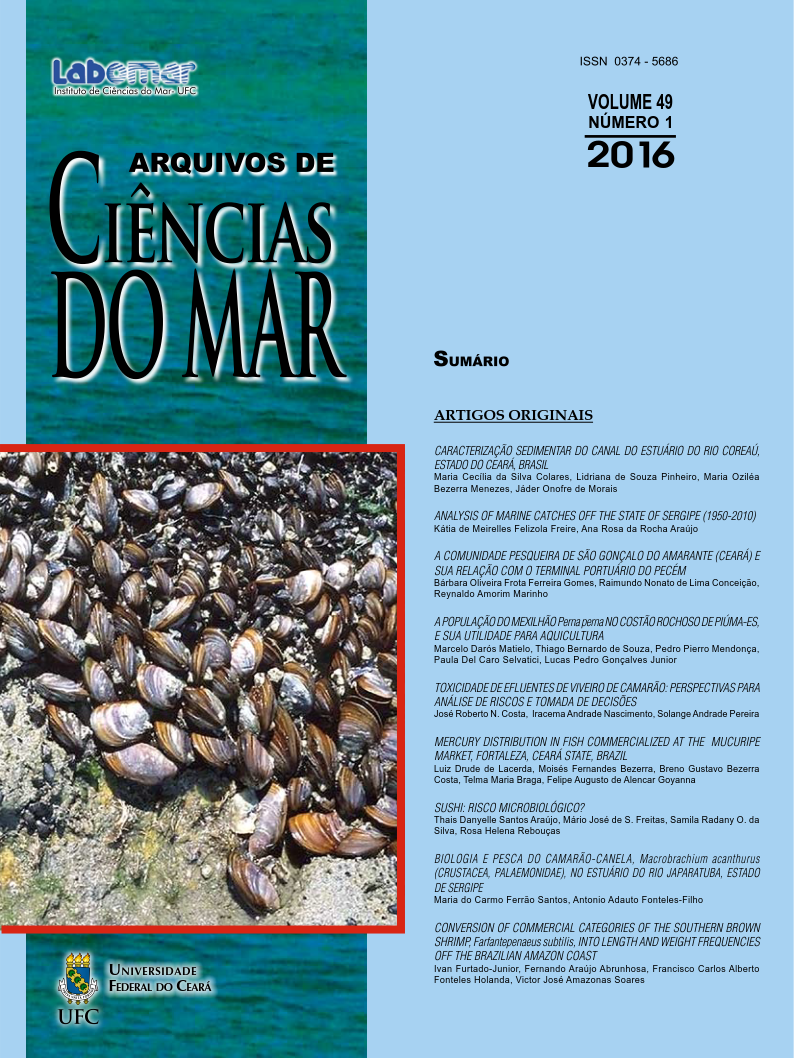SUSHI: RISCO MICROBIOLÓGICO?
DOI:
https://doi.org/10.32360/acmar.v49i1.6160Palabras clave:
sushi de salmão, risco microbiológico, estafilococos, coliformes, intoxicação alimentar.Resumen
A presença de estafilococos coagulase positiva e coliformes a 45ºC em alimento que será consumido cru representa potencial risco à saúde do consumidor. Buscou-se averiguar a presença de bactérias pertencentes aos grupos dos estafilococos e coliformes em sushis confeccionados à base de salmão comercializados em Parnaíba/PI. Foram realizadas análises para determinar as contagens de Bactérias Heterotróficas Cultiváveis (BHC), estafilococos coagulase positiva e NMP de coliformes a 45ºC. Os resultados foram comparados aos limites aceitáveis pela RDC nº 12 de 2001 (ANVISA). As contagens de BHC variaram de 1,3 x 10 5 a 4,0 x 10 7 UFC/g e 4,6 x 10 4 a 2,2 x 10 5 UFC/g para os estabelecimentos A e B. As contagens de estafilococos coagulase positiva para as amostras coletadas no estabelecimento A indicaram níveis acima do permitido e ausência para o estabelecimento B. A presença de coliformes a 45ºC foi confirmada para os dois estabelecimentos, no entanto, 25% das amostras do estabelecimento B expressaram níveis acima do permitido. O presente estudo demonstra o risco microbiológico em sushi preparado à base de salmão cru ao confirmar a presença de bactérias patogênicas em concentrações acima do permitido pela legislação nacional vigente.
Descargas
Publicado
Número
Sección
Licencia
1. Proposta de Política para Periódicos de Acesso Livre
Autores que publicam nesta revista concordam com os seguintes termos:
- Autores mantém os direitos autorais e concedem à revista o direito de primeira publicação, com o trabalho simultaneamente licenciado sob a Licença Creative Commons Attribution que permite o compartilhamento do trabalho com reconhecimento da autoria e publicação inicial nesta revista.
- Autores têm autorização para assumir contratos adicionais separadamente, para distribuição não-exclusiva da versão do trabalho publicada nesta revista (ex.: publicar em repositório institucional ou como capítulo de livro), com reconhecimento de autoria e publicação inicial nesta revista.
- Autores têm permissão e são estimulados a publicar e distribuir seu trabalho online (ex.: em repositórios institucionais ou na sua página pessoal) a qualquer ponto antes ou durante o processo editorial, já que isso pode gerar alterações produtivas, bem como aumentar o impacto e a citação do trabalho publicado (Veja O Efeito do Acesso Livre).

